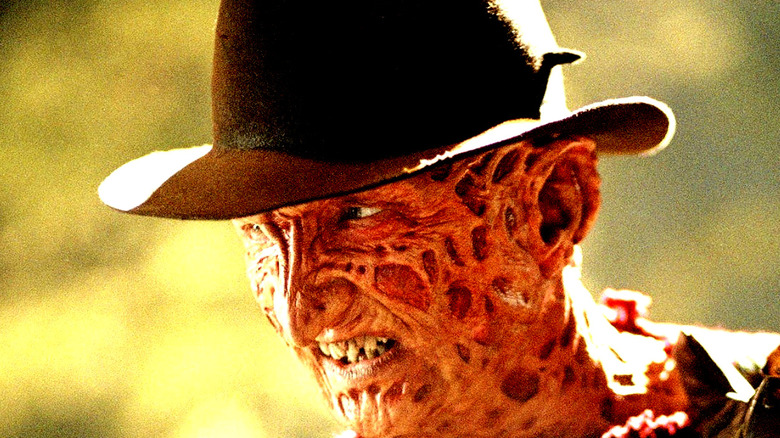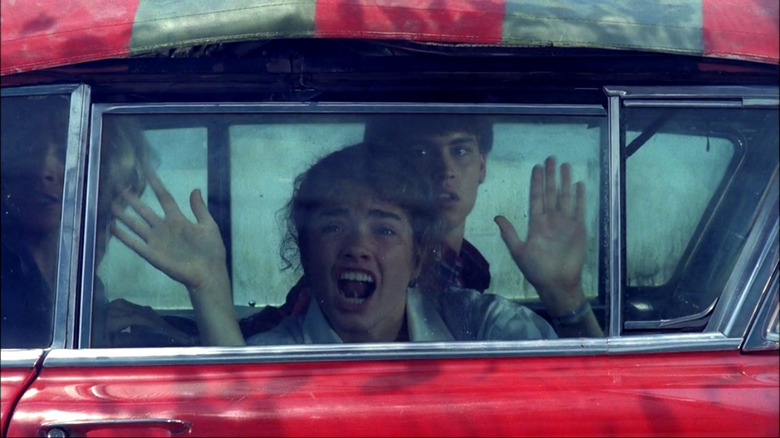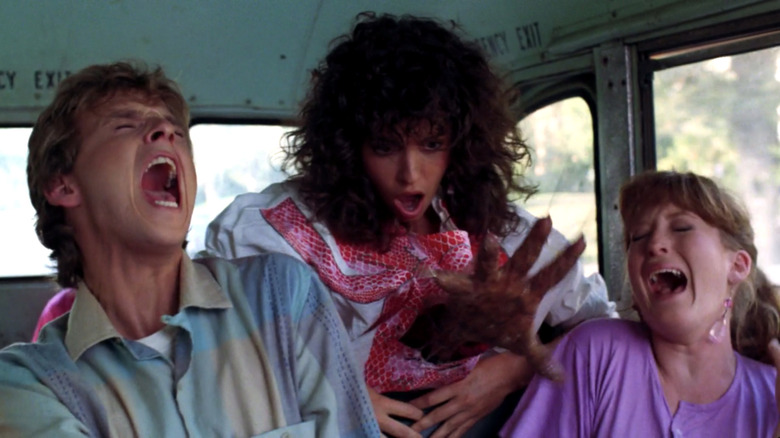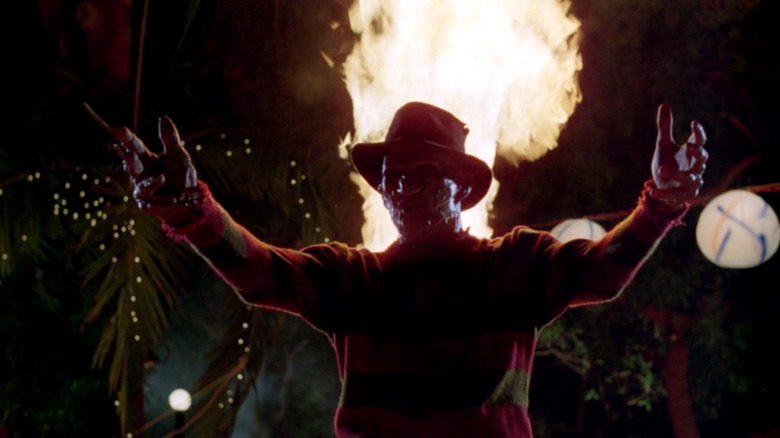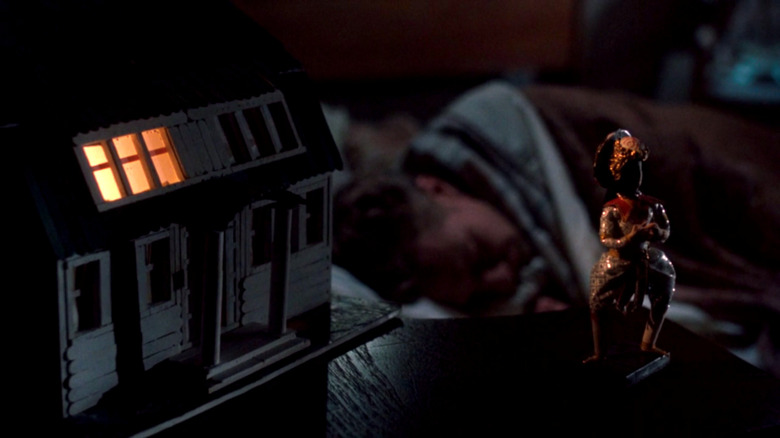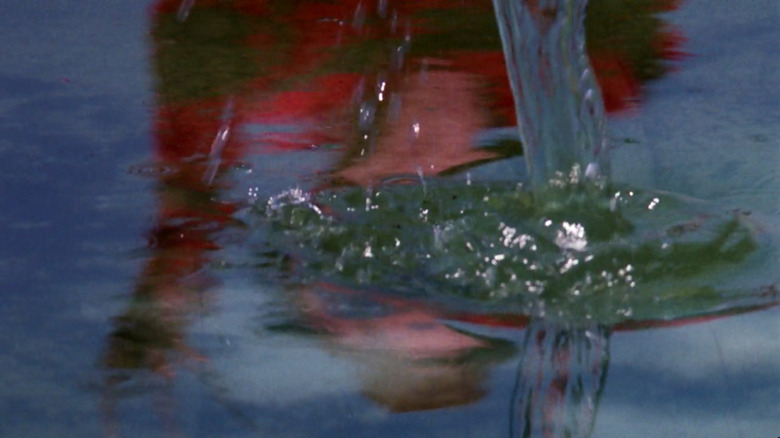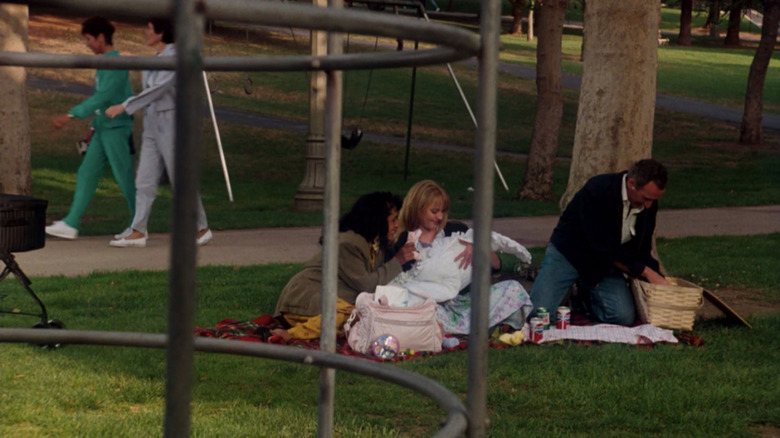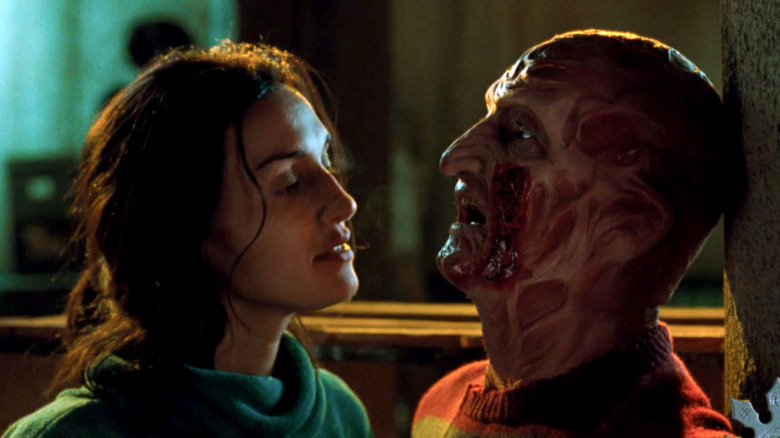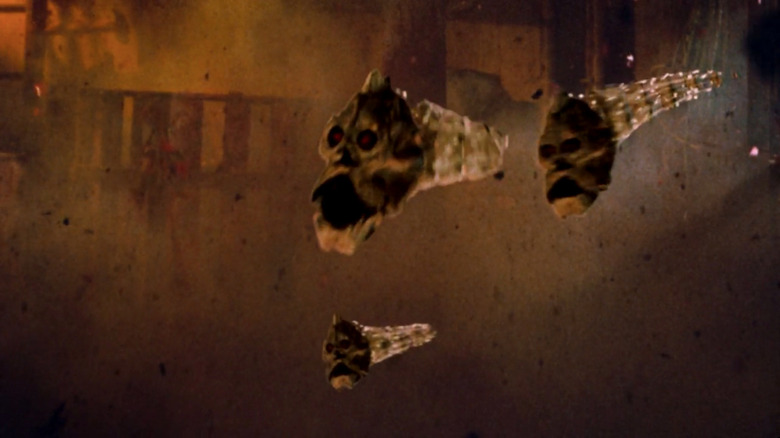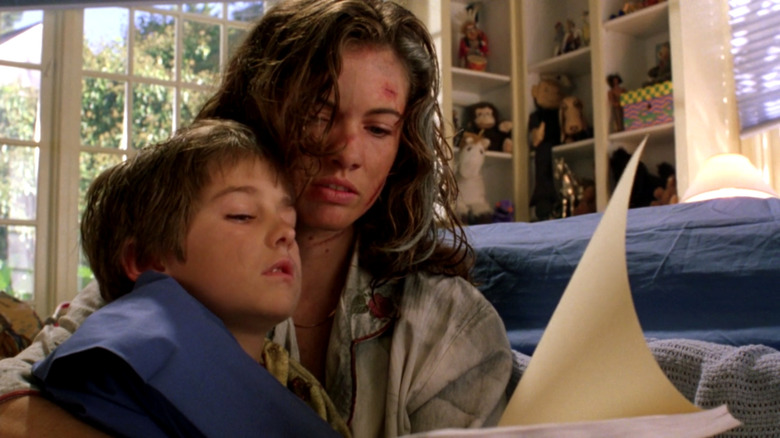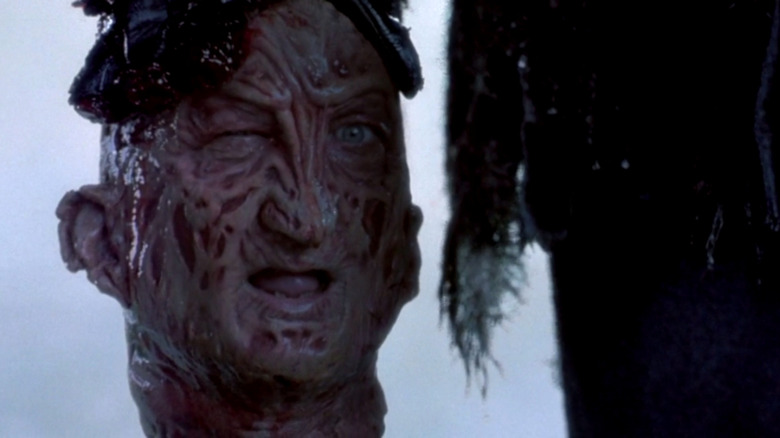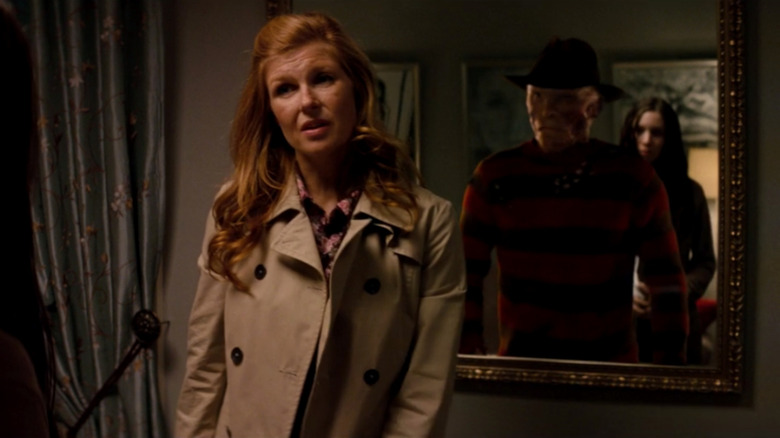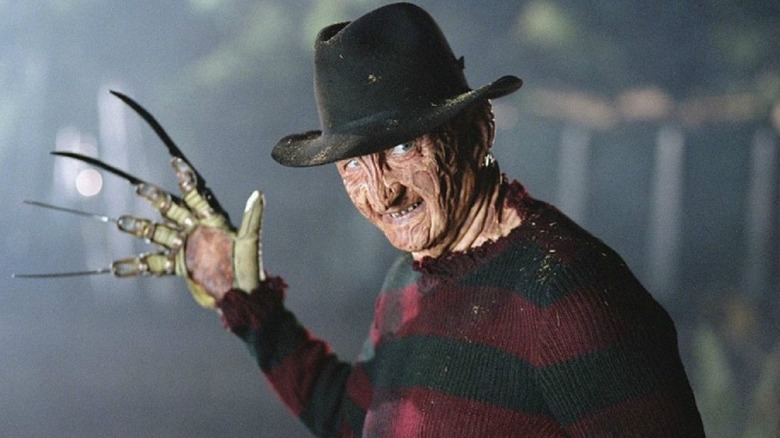Every Nightmare On Elm Street Movie Ending Explained
In the 1980s, slasher films were a huge deal. Killers like Jason Vorhees in "Friday the 13th" and Michael Myers in "Halloween" were slaughtering teenagers in droves, and real-world teenagers (not to mention horror-loving adults) couldn't get enough of it. Although both had a head start on Freddy Kreuger, in 1984 Wes Craven's "A Nightmare on Elm Street" came along, introducing a new, subconscious-level element to the slasher genre — and the "Son of a Hundred Maniacs" went to work assembling a bodycount to rival the competition.
Unlike lumbering, silent, masked killers Jason and Michael, Freddy (played by Robert Englund) was talkative, humorous, and in a perverse way even likable. What's more, he used his supernatural powers to hunt and kill his victims in their dreams — an inspiration that struck Craven after reading a real-life LA Times article about Cambodian genocide refugees.
According to the first film, Freddy was a child murderer who managed to escape prosecution on a technicality, leading a group of local parents to burn him to death in an act of vigilante justice. Years later, he returned as a powerful, vengeful specter determined to haunt the dreams of his killers' children.
One of the things Freddy's movies are known for is their dark, twisty endings. By 1984, the killer coming back to life at the last moment was already a trope, but Freddy's unique powers and the dream logic of the "Nightmare" movies enabled much flashier final shocks. Over the course of nine films, these endings were sometimes followed up on in future films, other times completely ignored. But for fans of the series, they're all memorable in their own unique ways.
With that in mind, let's look at the endings of all the "A Nightmare on Elm Street" movies, what they mean, and where it all leads.
A Nightmare on Elm Street (1984)
Wes Craven's original 1984 "Nightmare" established the kind of "shock" ending the franchise would become known for, although the first film's ending has rarely if ever been topped.
After final girl Nancy (Heather Langenkamp) manages to pull Freddy out of her dream and into the waking world, she uses a combination of booby traps and self-determination to apparently destroy him. A happy ending shows us the aftermath, as it's a beautiful morning and she is stepping outside her house to discover everyone is alive again and everything is back to normal.
Nancy's mother (Ronee Blakley) seems fine now despite being attacked by Freddy earlier; in fact, all of Freddy's victims are alive again, as boyfriend Glen (Johnny Depp) and their friends (Jsu Garcia and Amanda Wyss) all pull up in a red convertible. Nancy gets in the car with her friends — when suddenly, the convertible top comes up on its own, its color scheme resembling Freddy's iconic sweater. All four teens are locked into the car by an unseen force as it drives away — just as Freddy's arm breaks through the window in the house's front door, grabbing Nancy's mother and pulling her in. As the movie ends, little girls in white are seen jumping rope to the "1, 2, Freddy's coming for you..." nursery rhyme heard earlier in the film.
Setting aside the fact that it's a great surprise ending that has become an instrumental element in an iconic film, the ending does raise questions about the nature of reality. Is Nancy supposed to be trapped in a dream? Is she just dreaming at this moment? Does this mean Freddy has won, or just that he's still a threat? Is Nancy as dead as her friends, or are they somehow still alive?
Looking back now, of course, "Elm Street" fans know that both Freddy and Nancy went on to return in future franchise films. Which makes this ending feel like even more of a cinematic non sequitur, since this scene was not the end of Nancy.
A Nightmare on Elm Street 2: Freddy's Revenge (1985)
Nancy Thompson doesn't appear in 1985's "A Nightmare on Elm Street 2: Freddy's Revenge," which is instead focused on Jesse Walsh (Mark Patton), a teenage boy whose family moves into the former Thompson house on Elm Street.
Over the course of the flick, Freddy repeatedly uses Jesse as a conduit to enter the waking world, literally emerging out of the young man's body. Once again seemingly defeated by the end of the movie, this time with the help of Jesse's love interest Lisa (Kim Myers), Freddy shows up one last time to get his ... you guessed it, revenge.
In the final scene, on yet another bright, sunny morning, Jesse and Lisa are riding the school bus with their friend Kerry (Sydney Walsh). The school bus speeds up, and Jesse begins to panic as he's reminded of an earlier nightmare. Lisa does her best to calm him down, and Kerry reassures him that it's all over now. Suddenly, Freddy's clawed hand bursts out of Kerry's chest, while the bus goes off the road into a desert. Freddy's laughter is heard as the movie ends.
Once again, viewers are left to ponder what's a dream and what isn't, and whether the monster we thought was defeated had actually triumphed once again. The second film is one of the more unusual entries in the "A Nightmare on Elm Street" series, but it's no more interested in finality than the rest of them.
A change in direction
In retrospect, "Freddy's Revenge" is an oddball among the "Nightmare" movies, and not just because of its much-discussed gay subtext. In the first "Nightmare on Elm Street," Freddy is nearly all-powerful in dreams, and pulling him into the waking world is the only way to defeat him, an idea that would be repeated in later sequels. Generally speaking, dreams are where Freddy feels at home, and where he'd rather be.
In "Nightmare on Elm Street 2," however, Freddy desperately wants to cross over into the material world, and still exhibits great power when he gets there. That's why he torments Jesse in the film — he's using the poor kid's mind and body as a vessel to move from dreams to reality. The film's climax even sees Freddy terrorizing the teens at a big pool party, literally chasing them around and dispatching anyone who gets too close, while everyone is seemingly wide awake.
Unfortunately, moving Freddy out of the dreamworld not only diminished his power, it diminished his uniqueness among horror film baddies. Fortunately, the third film made a concerted effort to get things back on track. Wes Craven returned as a writer (although he didn't direct), and Heather Langenkamp came back to play Nancy as well. Much of what had happened in the sequel was ignored, and Freddy was once again a creature of dreams.
A Nightmare on Elm Street 3: Dream Warriors (1987)
In 1987's "A Nightmare on Elm Street 3: Dream Warriors," Nancy is a counselor to a group of troubled teens who also happen to be the last of the Elm Street kids — those whose parents killed Freddy Krueger. When Freddy comes for them, Nancy and the kids use hypnosis and the special powers of a girl named Kristen Parker (Patricia Arquette) to all enter the same dream, where they can take on Freddy together and stand a chance. Meanwhile, their psychiatrist Dr. Neil Gordon (Craig Wasson) goes looking for Freddy's skeleton, having been told by a helpful nun (Nan Martin) that his bones must be laid to rest to defeat him.
In the climactic battle, Nancy is fatally wounded by Freddy but manages to stab him with his own glove, even as Neil buries the skeleton. Once again, Freddy is seemingly destroyed. At Nancy's funeral, Neil has a vision of the nun he met before, and discovers she was actually the ghost of Freddy's mother. In the final scene, Neil is asleep in bed, while a model Kristen had constructed of the Elm Street house — the one from the first two movies — sits nearby. Suddenly, as the movie ends, a light comes on in the miniature house.
This stinger is obviously much more ambiguous than the first two. While the light could mean that Freddy's still around, it could just as easily be Nancy's spirit or some other force. After all, this movie establishes for the first time that Freddy is neither the only dead person who interacts with the living, nor the only person with dream powers. Whoever turns that light on, it still serves the purpose of telling viewers that the story isn't over.
A Nightmare on Elm Street 4: The Dream Master (1988)
Kristen Parker returned in 1988's "A Nightmare on Elm Street 4: The Dream Master," although Arquette was replaced in the role by Tuesday Knight.
The last of the Elm Street kids, Kristen passes on her dream powers to her friend Alice Johnson (Lisa Wilcox) before Freddy kills her. Unfortunately, this also leads to Freddy expanding beyond the Elm Street kids, now murdering any teens he wants. As her friends die, however, Alice is able to take on their skills as well, until she becomes a match for Freddy. When she defeats Freddy in the dream world, the spirits of her friends and his other victims escape into the sky.
In an epilogue set months later, Alice is on a date at the park with her boyfriend Dan (Danny Hassel). He throws a coin into a fountain, telling her to make a wish. As Alice watches the coin splash into the water, she momentarily sees Freddy's reflection, but doesn't let on. Dan asks what her wish was, but she refuses to tell him as they walk away.
Obviously, the reflection hints at Freddy's continued presence, although the audience doesn't really know if it's just in Alice's mind. It also isn't clear what her wish is, although the obvious guess is that it's for Freddy Krueger to stay gone. Even if he is gone for good (which, of course, he isn't) Freddy is obviously still haunting Alice from beyond.
A Nightmare on Elm Street 5: The Dream Child (1989)
Alice and Dan returned in 1989 for "A Nightmare on Elm Street 5: The Dream Child," and of course, so did Freddy.
In this fifth film, when Alice gets pregnant with Dan's child, Freddy uses the unborn baby as a conduit to attack her friends, feeding the fetus the souls of his victims to corrupt it. Although Freddy kills Dan and several of their friends, Alice manages to save her friend Yvonne (Kelly Jo Minter), then free herself and her child from his influence with the help of the spirit of Freddy's mother (Beatrice Boepple).
In yet another bright, sunny epilogue scene, Alice and her baby are having a picnic at the park with Alice's father (Nicholas Mele) and Yvonne. Nothing disturbs their nice day — but as the camera pulls back, a group of girls in white are jumping rope to the Freddy Krueger rhyme, just like at the end of the first movie. Freddy may not be here, but his presence is nevertheless felt in this world, and all too close to Alice and her child.
Freddy's Dead: The Final Nightmare (1991)
In "Freddy's Dead: The Final Nightmare," it turned out Krueger did have a child of his own, although it had nothing to do with Alice Johnson and her son (who don't appear in the movie at all).
In the bleak time of this sixth installment, Freddy has basically killed all the children and teens. One amnesiac boy called John Doe (Shon Greenblatt) wakes up outside of town after encountering Freddy in a dream, and begins to suspect that he's the killer's son. It turns he's wrong, but his doctor Maggie Burroughs (Lisa Zane) is Freddy's daughter, who was adopted and renamed after his arrest. Freddy kills John Doe, but Maggie is determined to defeat her father with the help of her colleague Doc (Yaphet Kotto) and another patient named Tracy (Lezlie Deane).
Maggie discovers that previous attempts to kill Freddy have always failed because the trio of demons who give him his powers are able to resurrect him over and over again as long as he dies in a dream. Armed with this knowledge, she manages to pull Freddy into the waking world, stab him with his glove, and insert a pipe bomb into the wound, fleeing as Freddy literally explodes. The three demons are seen abandoning Freddy, as they are unable to resurrect him in the real world. As the trio leave, Maggie smiles at Doc and Tracy and says definitively: "Freddy's dead."
This is the first movie in the series with absolutely no ominous moment at the end. As far as "The Final Nightmare" is concerned, its title was literal and Krueger would never be seen again. Of course, until it wasn't.
The story ends, making way for new beginnings
The sixth film was intended to be the final entry in the series. The three dream demons were specifically created not just to establish how Freddy had previously come back after being defeated in each movie, but to make his death in this movie different from the others. By explaining how he had been previously resurrected, the idea was to establish that it definitely didn't happen this time.
In a sense, "Freddy's Dead: The Final Nightmare" is successful in this bid for finality. While there are obviously still three more movies to go on this list, none of them are regular entries in the original "A Nightmare on Elm Street" series. One is an extremely meta take on the concept, one is a crossover, and one is a remake. So, while the efforts of his heroic daughter and his abandonment by the dream demons didn't stop Freddy from ever appearing again, you could say they did keep him from being casually resurrected for another cookie-cutter sequel (or maybe the film's critical failure did that). Either way, the Freddy Krueger status quo was over, and any future films would have to do something new.
Wes Craven's New Nightmare (1994)
Simply put, 1994's "Wes Craven's New Nightmare" isn't set in the same world as the other films in the series. In fact, it takes place in a world that looks, at least at first glance, much more like our own, although it ultimately turns out to feature the same kind of supernatural elements as the usual "Elm Street" setting.
As the title makes explicit, Wes Craven returned to the series for the first time since the third movie, and to the director's chair for the first time since the first. Heather Langenkamp also returned to star. In this film she plays a fictionalized version of herself, a 30-ish actress best known for playing Nancy in "A Nightmare on Elm Street," who has done her best to leave that role behind. She lives in L.A. with her special effects artist husband Chase Porter (David Newsom) and their son Dylan (Miko Hughes). Strange events begin occurring after Heather has a dream about Freddy Krueger attacking her family. After talking to her friends Wes Craven (playing himself) and Robert Englund (playing a dual role as himself and Freddy), Heather comes to realize that a real demonic spirit inhabits the character of Freddy Krueger, and now that the movie series is over, that evil is crossing into the real world. Freddy kills Chase, and as the conflict continues Heather finds herself falling into the Nancy Thompson role again.
With the help of her son Dylan, Heather finally manages to trap Freddy in a furnace and light it, destroying the creature, who transforms into its horned demonic form as it dies. Mother and Son return to the waking world, where Heather finds that Craven has left her a screenplay for a new movie — this movie. She begins reading the screenplay to Dylan as the film concludes.
There's no shock at the end of this movie, and Freddy (or the demon who had taken his shape) seems to be completely destroyed. There were never any sequels set in this continuity, so it seems safe to assume that Heather Langenkamp and her son lived happily ever after, with Freddy Krueger once more confined to fiction — where he belongs.
Freddy vs. Jason (2003)
The Freddy who returns to fight the silent killer of the "Friday the 13th" movies in the long-awaited 2003 crossover film "Freddy vs. Jason" is the version who died in "Freddy's Dead," not the demonic figure of "New Nightmare." The role of the previously established dream demons in enabling another resurrection goes undiscussed, but the movie does start with Freddy trapped in hell.
After all these years, the current generation of Elm Street kids don't remember Freddy, which means they can't fear him, which means he's nearly powerless. He uses the last of his power to resurrect Jason Vorhees (Ken Kirzinger) and sends him on a murderous rampage that will once again instill fear and inevitably be blamed on Freddy, thus enabling him to regain his former power. This plan backfires for Freddy when Jason starts killing teens that Freddy wants to kill himself, and it's not like you can just tell Jason Vorhees, "Hey, stop that," and expect him to listen. That's where the "versus" comes in.
Freddy and Jason first fight in a dream, where Freddy naturally has the upper hand, but then final girl Lori Campbell (Monica Keena) manages to pull Freddy out of the dream and into the real world, where Jason has the upper hand. Their climactic battle happens at Crystal Lake, where Jason is virtually unstoppable. He manages to sever Freddy's arm and stab him with his own clawed glove, which gives Lori a chance to decapitate Freddy with Jason's machete. Both Freddy and Jason fall into the lake, apparently dead.
The final scene is set in daylight an unspecified amount of time later. Jason rises from the lake and walks to shore, carrying Freddy's severed head. As they pass the camera, Freddy winks, letting viewers know that he'll be back. Ironically, this time he wouldn't be. At least, not this same Freddy.
A Nightmare on Elm Street (2010)
In all eight of the movies discussed so far, Freddy Krueger was played by Robert Englund. For more than 25 years he was inseparable from the character, and the character was inseparable from him, but in 2010 Jackie Earle Haley was cast in a remake of "A Nightmare on Elm Street," directed by Samuel Bayer (aka the director behind Nirvana's iconic "Smells Like Teen Spirit" video).
The remake has a similar plot to the original movie, but much darker. Freddy is portrayed as a child molester rather than a child murderer, and the teens who he is killing in their dreams are his former victims, although it takes them a while to put that together. In keeping with that change, Haley's Freddy isn't the charismatic jokester that Englund always was — he's a grim killer with a more realistically burned face. As in the original movie, Nancy (Rooney Mara) eventually manages to pull Freddy out of her dream and seemingly kill him in the real world, attacking him with a paper cutter blade and then setting the room on fire, mirroring his original death.
In the final scene of this version, Nancy and her mother Gwen (Connie Britton) arrive home from the hospital after the whole ordeal seems to be over. Suddenly, Freddy appears in a mirror behind Gwen, terrifying Nancy. He shatters the mirror and drives his claws through Gwen's face, killing her and then pulling her back into the mirror, which reassembles as if it was never broken, except it's now splattered with Gwen's blood. Suddenly alone, Nancy screams as the movie ends.
Unfortunately, the problems with this ending reflect the problems with the remake as a whole. There's no longer any ambiguity in the final shock, and no dreamlike absurdity either. Instead of the weirdness of Ronee Blakley being pulled through a tiny window, we just have to watch Freddy's blades stab through Connie Britton's face. The horror that once felt fun and off-puttingly silly is now just grim and upsetting. The consequence is the revelation that Freddy's still alive is meaningless, because there will be no sequel to this version.
Is Freddy really dead?
The 2010 remake made money, but critics and most audiences hated it. Jackie Earle Haley was no Robert Englund, and the movie's humorless writing certainly didn't do him any favors. So, is that really the end for Freddy Krueger? Has an unpopular remake and an unsuccessful recasting accomplished what decades of fictional teens failed at, and finally killed Freddy once and for all?
For now, it sure seems that way. Haley's failure to be embraced in the part proved just how inseparable Freddy is from Robert Englund, and Englund is in his mid-70s and certainly not getting any younger. So, it might be time to let go of Freddy Krueger and focus on a newer generation of monsters, like Annabelle, the Firefly family, and those aliens that kill you if you make noise.
On the other hand, it's hard to keep a good franchise down, and there may come a time when New Line Cinema decides it's time to make another swing at "A Nightmare on Elm Street," probably with a third actor wearing Freddy's glove, scars, and fedora. And who knows? It might work next time. It doesn't hurt to dream — or does it?
